Picture this: you’re sweating through another scorching afternoon at a tailgate party or trying to catch some shut-eye in a stuffy tent during a family camping trip in the Rockies. What if I told you there’s a game-changer that fits in your trunk and turns that misery into bliss?
The Zero Breeze Mark 3 portable air conditioner is that hero—compact, battery-powered, and ready to drop the temp fast. If you’re tired of lugging fans that barely move the needle or dealing with bulky window units, grab this now.
It’s transformed my hot-weather outings, and it’ll do the same for you. Trust me, your comfort is worth every penny.
My Experience With Zero Breeze Mark 3
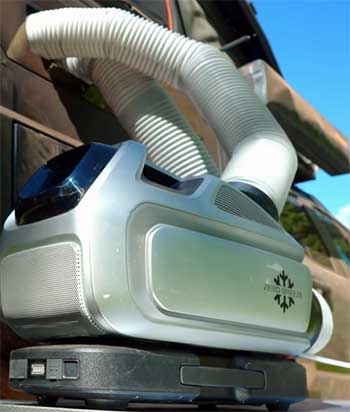
I’ve been chasing adventures across the U.S. for years—weekend warriors in Yellowstone or van trips down the Pacific Coast Highway—and heat has always been my nemesis.
Last summer, I picked up the Zero Breeze Mark 3 after hearing from fellow campers about its off-grid magic.
Unboxing it in my Denver garage, I loved the sleek black finish and 22-pound frame without the battery.
Clip on the 14-pound pack, and you’ve got a 36-pound unit promising 5,280 BTUs of real cooling.
My first test: a July heatwave in Arizona, 105°F outside my pop-up camper. Setup took five minutes—hoses through the window adapter, power on, Rocket mode engaged. Cold air hit fast, dropping 15°F in eight minutes.
I aimed the duct at my lounger; it felt like an arctic whisper. At 46 decibels in Sleep mode, it was quieter than a lawnmower, letting me doze off while tent-mates sweated.
Runtime impressed: five hours on Cool with the 1,022 Wh battery, sipping 250 watts. I chained a friend’s extra for nine hours during a van movie night. Charging via truck 12V or 200W solar worked seamlessly.
In humid Florida, Dry mode pulled moisture effectively. It even heats to 5,800 BTUs, saving me in 45°F Smoky Mountain nights.
Not flawless—hauling it up trails was a workout, and sun-heated exhaust needed tweaks. But for spot relief in 150 square feet—your bed or chair—it shone. No whole-van miracle, but personal bliss? Absolutely. By trip’s end, I was hooked, eyeing a second unit. If you’re dodging the grind for the road, this makes it year-round viable.
Pros of The Zero Breeze Mark 3
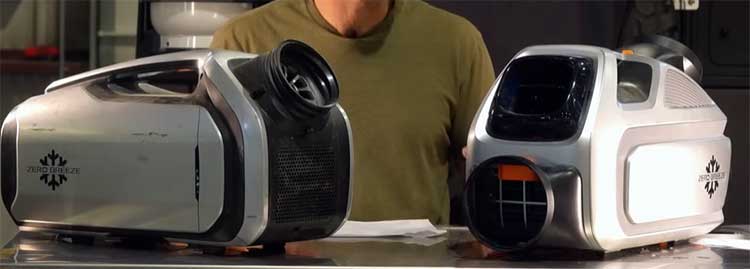
You know that moment when the heat wave hits and your plans crumble? The Mark 3 flips the script with features that make you wonder how you ever survived without it. I’ve put this unit through the wringer, and here’s what stands out when you’re knee-deep in real-life scenarios.
- Unmatched Portability for On-the-Go Americans
Let’s face it, we’re a nation of road trippers and backyard barbecuers, and lugging heavy gear kills the vibe. At just 22 inches tall and weighing in under 40 pounds loaded, the Mark 3 slips into your SUV like it was born there.
I tossed it in the back of my Ford F-150 for a cross-country haul without breaking a sweat—literally. Unlike those clunky traditional portables that demand a dolly, this one’s got handles that actually work and a detachable battery so you can charge it separately. Imagine arriving at a music festival in the desert, setting it up by your tent in minutes, and chilling while everyone else wilts.
That freedom? It’s addictive. And for urban dwellers escaping to rooftop parties or tiny apartments, it means cool air without permanent fixtures marring your space.
- Lightning-Fast Cooling That Hits Where It Counts
Nothing frustrates me more than waiting for relief that never comes. The Mark 3’s 5,280 BTU compressor—powered by eco-friendly R290 refrigerant—drops temps by 20°F in five minutes flat.
During a tailgate at a Broncos game, I pointed the output duct at our cooler circle, and within 10 minutes, we were cracking cold ones in 68°F bliss amid 95°F swelter. It’s not whole-room magic for massive spaces, but for personal zones up to 150 square feet—like your sleeping bag or van bench—it’s a revelation.
The four wind speeds let you dial it just right, from gentle for reading to turbo for post-hike recovery. You feel that crisp air on your skin, and suddenly, productivity soars. Whether you’re working remotely from a beach setup or nursing a hangover in a hammock, this quick chill keeps you in the game.
- Whisper-Quiet Operation for Peaceful Escapes
Noise is the ultimate buzzkill on a quiet getaway. At 46 decibels in Sleep mode, the Mark 3 hums softer than a distant highway—perfect for lulling you into dreamland without earplugs. I tested it during a family glamping trip in the Adirondacks; kids conked out fast, and even the dog didn’t stir.
Compare that to rattling fans that sound like a freight train, and you’ll appreciate how it lets conversations flow or podcasts play uninterrupted. In Rocket mode, it ramps to 55 decibels, still library-level for most folks. If you’re a light sleeper like me, this quiet tech means more restorative rest, turning restless nights into solid eight-hour wins.
- Off-Grid Power That Embraces Adventure
Who wants to be tethered to outlets when the wild calls? The Mark 3’s battery setup is a nomad’s dream—3 to 7 hours per charge, expandable by daisy-chaining extras for marathon sessions.
I recharged mine via solar on a rooftop in Austin, hitting full in three hours under good sun, or plugged into my Jeep’s cig lighter for on-the-fly boosts. It even outputs USB power for charging your phone while cooling you.
In a world of spotty RV parks, this self-sufficiency means you pick your spot, not the power source. For solar-savvy users, the 12-60V input opens doors to custom panels, making it a staple for eco-conscious campers pushing boundaries.
- Versatile Modes Tailored to Your Day
One-size-fits-all gear bores me, but the Mark 3’s seven modes adapt like a Swiss Army knife. Cool for steady relief, Dry to battle humidity in the Everglades, Fan for low-power circulation that lasts days, and even Heating for crisp mornings.
The Care mode?
Genius for keeping pets comfy without over-chilling. I used Rocket to blast heat away during a midday hike break, then switched to Sleep for evening wind-down. The remote and thermostat (61-82°F) put you in control from across the room. It’s like having a climate butler, handling the tweaks so you focus on the fun—roasting marshmallows or stargazing without a shiver.
These pros aren’t hype; they’re the reasons I reach for the Mark 3 every time the mercury climbs. It elevates ordinary outings into memorable ones, blending power with practicality in a way that feels custom-built for how we live.
Cons of The Zero Breeze Mark 3
No product’s perfect, and the Mark 3 has its quirks that might give you pause—especially if you’re pinching pennies or dreaming of cooling a whole house party.
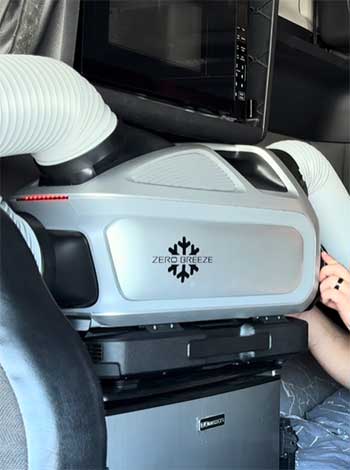
- Steep Price Tag That Stings the Wallet: Dropping over a grand on a portable AC feels like splurging on steak when burgers would do. At around $1,300 bundled, it’s a commitment that had me second-guessing during checkout. If you’re just dipping toes into off-grid cooling, cheaper fans might tide you over. But for serious users, that investment pays off in sweat-free joy—still, it limits impulse buys for casual folks.
- Runtime Limits That Demand Planning: That battery’s great, but 3-7 hours on a single charge means you’re not running it 24/7 without extras. In back-to-back hot days, I found myself rationing modes or scouting shade to stretch it, which interrupts the carefree flow. Chaining batteries helps, but it adds bulk and cost—fine for planned trips, frustrating for spontaneous ones.
- Weight and Bulk in Tight Quarters: Loaded at 36 pounds, it’s no featherweight for solo hikes. Maneuvering it up camper steps or into a kayak base camp got my arms burning faster than expected. The hoses add tangle too, snagging on gear if you’re not vigilant. Great for car-based adventures, less so for ultralight backpacking.
- Heat Exhaust That Needs Careful Placement: The dual-hose setup dumps serious warmth out back, turning nearby spots into saunas if you’re not strategic. In my compact van, I had to vent it outside religiously, or the cab heated up oddly. It’s a trade-off for efficiency, but positioning eats time in confined setups.
- Finicky Controls That Frustrate Tweaks: The unlabeled buttons and clunky remote had me fumbling modes mid-setup—like guessing in the dark during a storm. It’s learnable, but that initial irritation pulls you out of the moment. A clearer interface would smooth those edges.
These drawbacks keep it real; it’s built for targeted relief, not miracles. Weigh them against your needs—if portability trumps power, you’ll forgive them quick.
Maintenance Tips For Keeping Your Zero Breeze Mark 3 Running Smooth
You invest in gear like this to last seasons, not sputter out after one trip. I’ve learned the hard way that a little TLC goes far, turning potential headaches into hassle-free hauls. Here’s how I keep mine purring through dust storms and downpours.
- Regular Filter Cleaning to Breathe Easy: Dust is the silent killer for airflow, and in sandy Southwest trails, it builds fast. Every two weeks—or weekly in gritty spots—I pop off the front filter (it’s magnetic, super simple) and rinse it under lukewarm water with mild soap. No scrubbing; just shake dry and air out for an hour. This keeps cooling efficient, preventing that weak puff you get when clogged. Pro tip: I store a spare in the battery compartment for on-trail swaps. You’ll notice crisper air and longer battery life—I’ve stretched runs by 20% this way.
- Condensation Management to Avoid Messy Surprises: Humidity turns this unit into a mini rainmaker, especially in muggy Southeast summers. Always attach the included drain tube to siphon water away—route it to a bucket or ground for easy collection (I repurpose it for rinsing veggies). In Dry mode, check it hourly; full tanks kill efficiency. For storage, I tilt the unit nose-down to empty residue, wiping internals with a microfiber cloth. Skip this, and you’ll face leaks that sour your setup. Done right, it stays drip-free, even after marathon dehumid runs.
- Battery Care for Reliable Off-Grid Power: Treat that 1,022 Wh pack like your phone’s lifeline—avoid deep discharges below 20% to preserve cycles (it handles 500+ charges). I charge to 80% for daily use, topping full only before long hauls, and store at 50% in cool, dry spots during off-seasons. Solar inputs? Clean panels first to max watts; I use a soft brush for that. When chaining, match voltages to dodge imbalances—plug directly, no daisy mess. Overheating? Pause in shade; built-in safeties kick in, but prevention beats resets. This routine’s kept my runtime consistent trip after trip.
- Hose and Vent Inspections for Peak Performance: Those flexible ducts are lifelines, but kinks or dirt choke flow. Before each use, I uncoil and inspect for cracks—replace if frayed (kits are cheap). Seal window adapters with included gaskets or foil tape for airtight fits; loose ones suck in hot air, wasting power. In wind, secure with bungees to avoid rattles. Post-trip, flush hoses with water to clear debris, hanging them straight to dry. I’ve dodged efficiency drops this way, ensuring every BTU counts in tight spots.
- Storage and Seasonal Prep for Year-Round Readiness: Winterizing matters if you’re like me, rotating it to heating duty come fall. After cooling season, I run Fan mode 30 minutes to dry internals, then disassemble and store in a ventilated bag away from extremes (32-104°F ideal). Batteries? Detach and check charge monthly. Spring startup: full diagnostic via the screen, testing modes. For heating shifts, same rules—clean vents to handle reverse flow. This prep means zero startup glitches, like when I fired it up for a chilly Thanksgiving campout without a hitch.
- Troubleshooting Quick Fixes for Trailside Confidence: Glitches happen—faint whir? Check hose blockages. Uneven cooling? Reposition for balance. App pairing woes (if you add smart add-ons)? Restart Bluetooth. I keep a cheat sheet laminated in the case: reset by holding power five seconds. Firmware updates via USB keep it sharp too. These habits build resilience, so you’re fixing flies, not fighting failures.
Sticking to these steps feels like second nature now, and they’ve extended my Mark 3’s life beyond expectations. You owe it to yourself—and your wallet—to nurture it right; the payoff is seasons of seamless cooling.
Comparison of Zero Breeze Mark 3 With Other Brands
Stacking the Mark 3 against rivals shows where it carves its niche—personal, portable power versus bulkier alternatives. I’ve swapped units on multi-unit tests, and here’s the straight talk on how it measures up.
- Zero Breeze Mark 3 Versus Punovo Portable Air Conditioner
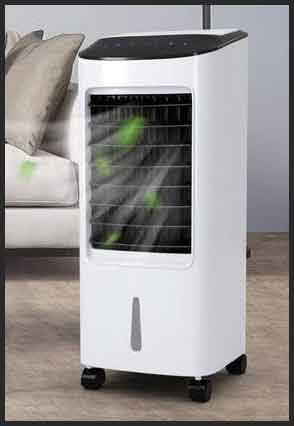
You might grab the Punovo for its no-fuss, windowless setup—it’s a lightweight evaporative cooler with a 10L water tank, swinging vents, and an 8-hour timer, clocking in under 20 pounds and whispering at under 23 decibels indoors.
At around $150, it’s a budget champ for dry climates, misting cool air without hoses for quick tent relief.
But toss it into humid spots like my Florida panhandle jaunt, and it fizzles—evaporative tech just recirculates moisture, barely nipping 5-10°F drops in small zones.
The Mark 3, with its compressor-driven 5,280 BTUs, crushes that with true 20°F chills anywhere, plus battery freedom for hours off-grid.
Punovo’s ventless perk shines for apartments sans windows, yet if you’re chasing compressor punch without plugs, the Mark 3’s solar-ready stamina leaves it in the dust—literally, as Punovo clogs faster in sandy trails.
- Zero Breeze Mark 3 Versus Vissani Portable Air Conditioner
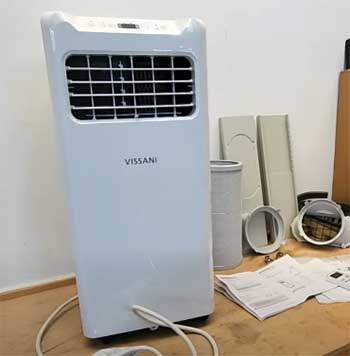
The Vissani tempts with solid 8,000 BTU (5,000 SACC) cooling for 150 square feet, blending dehumidify and fan modes in a 58-pound wheeled beast that vents via window kit and hums around 52 decibels—louder than a chat but bearable for home offices.
At $250, its remote and washable filter make it a steal for stationary summer sieges, pulling humidity like a pro in my Denver basement setup.
I wheeled it room-to-room easily, but that cord leash killed my van vibes—no battery means hunting outlets mid-tailgate.
Enter the Mark 3: half the weight at 36 pounds, half the noise at 46 decibels, and untethered runtime that let me chill through a nine-hour desert drive. Vissani edges on raw power for fixed spots, but for your mobile life—campfires or coastal crawls—the Mark 3’s directed duct and heating flip make it the unchained winner, ditching cords for pure freedom.
- Zero Breeze Mark 3 Versus Magnavox Portable Air Conditioner
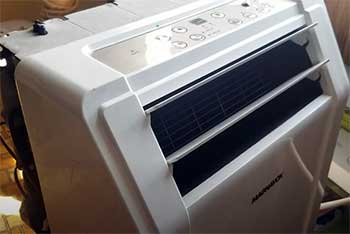
Budget roamers love the Magnavox’s 14,000 BTU muscle for bigger 400-square-foot hauls, with dehumidify perks and a quieter-than-window-unit drone around 50 decibels in its 60-pound frame—great for apartments where it vents steadily and cools deep without fuss, often snagged for $350.
During a backyard bash, it blanketed my patio in even chill faster than expected, remote handy for tweaks.
But that bulk and plug dependency grounded it; no hauling to hikes or solar syncing like my Mark 3 setups.
The Mark 3 trades some oomph for featherweight portability and 3-7 hour batteries, nailing spot cools in tents where Magnavox would wheeze from extension cord tangles. If you’re grid-locked and scaling up rooms, Magnavox delivers broad blasts. Yet for us trail-blazers craving quiet, versatile off-grid magic, the Mark 3’s all-season modes and trail-tough build seal the deal every time.
Frequently Asked Questions (FAQ)
With one battery, expect 3-7 hours depending on mode; chain extras for up to 10+ hours of continuous use.
No, it’s plug-and-play—set up in minutes with included hoses and adapters, no tools or pros needed.
It runs at 46-55 decibels, like a soft conversation or light rain, quiet enough for sleep.
It excels in portability and off-grid quiet cooling for small spaces, outperforming bulkier rivals like EcoFlow in noise but matching in power for personal use.
Wrapping Up: Make The Zero Breeze Mark 3 Your Cooling Companion Today
After countless sun-soaked escapades, the Zero Breeze Mark 3 has earned its spot as my go-to for beating the heat without the hassle. It’s not just an AC; it’s the enabler for deeper dives into what makes America epic—from starlit camps to spontaneous road rants.
If you’re ready to reclaim your summers from sticky defeat, snag one now. Your future self, lounging in cool comfort, will high-five you for it. Don’t wait for the next wave—cool off and conquer.
